Parenting Tips
Defining Orphanhood: Can You Be an Orphan With One Parent?
Perceptions of orphanhood shift from traditional views to modern understandings, exploring the complexities of being classified as an orphan with just one parent.

Losing one parent can mark someone as an orphan. Though some think both parents need to be gone, today, losing just one counts. Various places have different ideas about it. Single-parent orphans face deep feelings, money troubles, and legal challenges. Support groups offer advice, stability, and friendships to ease these issues. **Orphanhood** isn’t just about losing parents; it also calls for kindness and empathy. Stick around to learn more about what makes an orphan and the support you can find.
Key Takeaways
- Orphanhood can include children who've lost one parent.
- Definition varies culturally and legally.
- Support systems are crucial for single-parent orphans.
- Legal implications impact benefits and rights.
- Understanding orphanhood complexities is essential.
Traditional Definition of Orphanhood
Explore the traditional understanding of orphanhood, which typically defines an orphan as a child under 16 who's lost at least one parent.
In traditional terms, the definition of an orphan often focuses on children who've tragically lost both parents. However, in some cases, the term may also include those who've lost just one parent. This definition is important as it helps NGOs and governmental agencies determine eligibility for benefits and services provided to orphans.
The concept of orphanhood can be complex, as perceptions may vary based on personal beliefs, cultural norms, and age. While some may associate orphanhood strictly with the loss of both parents, others acknowledge the challenges faced by children who've lost just one parent.
It's essential to take into account these nuances when discussing orphanhood to ensure that all individuals who've experienced parental loss receive the support and recognition they deserve.
Nuanced Perspectives on Orphanhood

The understanding of orphanhood can vary greatly, reflecting diverse cultural, legal, and personal perspectives on parental loss. Some definitions consider children who've lost one parent as orphans, while others focus on the loss of both parents. This diversity in the definition of orphanhood can lead to different perceptions among individuals and organizations regarding who qualifies as an orphan.
Legal frameworks and social norms also play a significant role in determining orphan status, influencing how individuals are classified and supported in society. These nuanced perspectives on orphanhood highlight the complexity of the experiences of those who've lost one or both parents.
Cultural Variations in Orphanhood Perception

Different cultures around the world have unique perspectives on orphanhood, impacting how individuals perceive themselves as orphans.
Family structures, societal norms, and community support networks all play a role in shaping these views.
Understanding global orphanhood norms can provide insight into the diverse ways orphanhood is defined and experienced across various cultural backgrounds.
Global Orphanhood Norms
Cultural perceptions play a significant role in defining orphanhood norms globally, influencing how individuals and societies view children with one living parent. In some cultures, an orphan is defined as a child who's lost one or both parents. However, definitions can vary widely across different countries and communities.
For example, while some societies consider children with one living parent as orphans, others may require both parents to be deceased for a child to be labeled as such. These variations in orphanhood norms are shaped by a range of factors, including religious beliefs, social customs, and legal systems.
For instance, certain religions may have specific guidelines for categorizing orphans based on parental status. Understanding these global differences in orphanhood perception is essential for providing appropriate support and care to children in need. By recognizing and respecting the diverse cultural norms surrounding orphanhood, we can better address the unique needs of orphaned children worldwide.
Family Structure Impact
Considering the diverse family structures across societies, perceptions of orphanhood can vary greatly. In some cultures, the definition of orphan extends to those who've lost one parent, while in others, both parents must be deceased for someone to be classified as an orphan. Here are some ways in which family structure impacts the understanding of orphanhood:
- Family Support Systems: The presence or absence of extended family members and their willingness to provide care can influence whether a child is considered an orphan.
- Cultural Beliefs: Societal norms and beliefs play a significant role in shaping how orphanhood is defined within a community.
- Legal Definitions: Some regions have specific legal criteria for determining orphan status, which may take into account the structure of the family.
- Parental Involvement: The level of involvement of the surviving parent in the child's life can affect whether the child perceives themselves as an orphan.
- Emotional Impact: Even with one living parent, some individuals may still feel the emotional weight of parental loss, leading them to identify as orphans.
Community Support Networks
In exploring the impact of community support networks on perceptions of orphanhood, it becomes evident that cultural variations greatly shape how individuals view and experience the loss of a parent.
Community support networks play an essential role in providing emotional and practical assistance to those who've experienced parental loss. In some cultures, these networks are deeply ingrained, offering a sense of belonging and support that helps individuals navigate grief and identity after losing a parent.
Different cultural perspectives on orphanhood can influence how individuals express their grief and seek support from their communities. Some cultures may emphasize collective mourning and communal care, while others may focus more on individual coping mechanisms.
Understanding these cultural variations is important in providing effective support to those affected by parental loss.
Emotional Challenges of Orphanhood

Amidst the complexities of orphanhood with one parent, emotional challenges such as feelings of loss, abandonment, and identity confusion can deeply affect individuals.
These challenges may manifest in various ways:
- Grief and Loneliness: A child who's lost a parent may struggle with the overwhelming emotions of grief and loneliness, longing for the presence and support of their deceased parent.
- Sense of Incompleteness: The absence of a parent can lead to a feeling of incompleteness, as children may yearn for the missing parental figure in their lives.
- Identity Confusion: Coping with the loss of a parent can result in identity confusion, as children undergo the process of defining themselves without the guidance and influence of that parent.
- Family Dynamics: Emotional challenges may include managing complex family dynamics, especially in blended families or situations where a new family structure is introduced.
- Support Systems: Utilizing support systems and therapy can be instrumental in addressing the emotional challenges faced by children with one living parent, providing them with tools to cope and heal.
Practical Needs of Orphans

As we shift our focus to the practical needs of orphans, it is important to address the fundamental requirements essential for their well-being and development. Orphans, especially those who have been abandoned or experienced abuse or neglect, require support in various aspects of their lives. Below is a table outlining some of the critical practical needs of orphans:
| Practical Needs | Description |
|---|---|
| Shelter | Providing a safe and stable living environment is essential. |
| Food | Ensuring access to nutritious meals for proper growth and health. |
| Education | Offering opportunities for learning and skill development. |
| Healthcare | Access to medical services and professionals for well-being. |
Meeting these essential needs is crucial for orphaned children to thrive and reach their full potential. Whether through orphanages, foster care systems, or community support networks, addressing these needs can make a significant difference in their lives.
Support for Children With One Deceased Parent
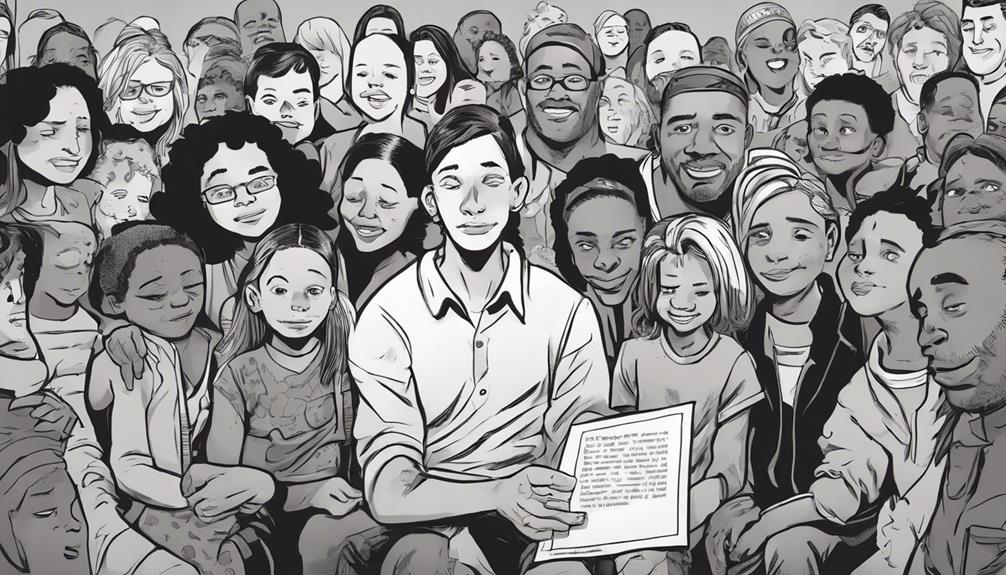
Losing a parent can be incredibly tough, but you're not alone.
There are organizations and support systems out there specifically designed to help kids like you who've lost one parent.
These resources provide emotional support, counseling, and guidance to help you navigate this challenging time with strength and resilience.
Parental Bereavement Impact
Children who've experienced the loss of one parent face significant emotional challenges that can impact their well-being and sense of security. Coping with parental loss is a difficult journey, but there are ways to support children who are dealing with the grief of losing a parent:
- Seek Counseling: Encouraging children to express their feelings and emotions in a safe environment can help them manage their grief effectively.
- Establish Routine: Creating a stable routine can provide a sense of security and normalcy during a time of upheaval.
- Encourage Open Communication: Keeping the lines of communication open allows children to ask questions and share their thoughts about the loss.
- Provide Comfort: Offering physical and emotional comfort through hugs, kind words, and gestures of affection can reassure children during this challenging time.
- Utilize Support Resources: Connecting with support groups, therapists, or other resources can offer additional guidance and assistance in dealing with the grieving process.
Single-Parent Orphan Support
After experiencing the loss of one parent, children may benefit from participating in single-parent orphan support programs that offer emotional and financial assistance. These support programs are designed to help single-parent orphans navigate the challenges of losing a parent by providing counseling, educational support, and access to resources. They aim to assist children in coping with grief, understanding their identity, and planning for their future.
Support for single-parent orphans recognizes the importance of maintaining a connection to the deceased parent while helping the child adjust to their new reality. Organizations and communities often come together to create a network of support and care for these children during their time of need.
Legal Implications for Orphans

Understanding the legal implications for orphans is essential for maneuvering the complexities of parental loss and accessing necessary support and resources. When it comes to legal frameworks surrounding orphan status, the implications can be significant.
Here are some key points to bear in mind:
- Orphan status may impact eligibility for benefits and rights under the law.
- Legal definitions of orphanhood play an important role in determining access to resources and support for children in need.
- Specific documentation is often required for orphan petitions and immigration processes to prove parental loss.
- The legal framework surrounding orphan status is crucial for ensuring proper care and support for vulnerable children.
- It's essential to navigate the legal landscape carefully to advocate for the rights and well-being of orphaned children effectively.
Understanding the Complexity of Orphanhood

Exploring the domain of orphanhood can be intricate due to the diverse definitions and circumstances surrounding parental loss. Orphan care is a multifaceted issue, encompassing children who've lost one or both parents.
Traditionally, an orphan is considered a child without any living parents. However, some children classified as orphans may actually have a surviving parent who's unable to provide care due to various reasons. This complexity highlights the need for a nuanced understanding of orphanhood.
When defining orphan status, organizations like UNICEF and World Vision provide guidelines that acknowledge the different situations children may face. Understanding the nuances of orphanhood is essential for ensuring that appropriate support and resources are allocated to children in need.
Frequently Asked Questions
Can Someone Be an Orphan With One Parent?
Yes, you can be considered an orphan with one parent. While traditional definitions mention the loss of both parents, some organizations broaden the term to include children who've lost just one parent.
This distinction can vary based on cultural beliefs. Support services are available for children in this situation because losing a parent can have profound effects.
What Is Legally Considered an Orphan?
Legally, an orphan is typically a child who's lost one or both parents. This status can extend to children with parents unable to provide care. The exact definition may vary based on location and circumstance, with specific criteria set by countries and organizations.
Understanding the legal framework is vital for offering the necessary care and support to children in need. It's important to take into account these definitions when addressing orphanhood and providing assistance.
What Defines You as an Orphan?
To be considered an orphan, the key factor is the loss of one or both parents. This definition may vary depending on cultural and legal perspectives.
Orphans may include children with deceased parents, those abandoned by caregivers, or kids in institutional care without parental support. Understanding the nuances of orphanhood helps guarantee proper care and support for these vulnerable individuals.
The term 'orphan' encompasses a range of situations requiring compassion and assistance.
Who Is Classified as an Orphan?
You're classified as an orphan if you have lost one or both parents or if your parents are unable to care for you. This definition varies among organizations, including UNICEF and World Vision.
Some children with parents in institutional care can be considered orphans. Abandoned children also fall under this classification.
The term 'orphan' is broad and can include different circumstances based on specific criteria. Remember, being an orphan doesn't define your worth or potential.
Can a Single Parent Qualify for Parenting Payment?
Yes, a single parent can qualify for parenting payment single amount in Australia if they meet the eligibility criteria. This payment provides financial support to single parents or carers who have the main responsibility for the care of a child under 8.
Conclusion
In the end, orphanhood is a complex and nuanced experience that goes beyond traditional definitions.
Whether you have lost one parent or both, the emotional challenges and practical needs of orphaned children are significant.
It's important to recognize and support all children who've lost a parent, as they navigate the complexities of growing up without one of their primary caregivers.
Remember, empathy is the key to truly understanding the depth of orphanhood.
Parenting Tips
Unleash Your Public Speaking Potential With Confidence
Dive into mastering public speaking with confidence by learning essential techniques to captivate your audience and overcome stage fright.

Boost your public speaking skills by nailing the basics. Know your audience and design a clear speech layout. Tackle stage fright with deep breaths and expressive body language. Handle Q&A sessions calmly and confidently. Use visual aids to make your point stronger. These tips will unlock your public speaking potential and skyrocket your confidence.
Key Takeaways
- Practice speaking in front of a mirror multiple times for confidence.
- Utilize deep breathing and visualization techniques to overcome stage fright.
- Tailor your speech to connect with the audience on a personal level.
- Embrace non-verbal communication through eye contact and confident body language.
- Use clear speech structure with a compelling opening and strong conclusion.
Preparation for Public Speaking
Preparing meticulously for public speaking is essential for delivering a successful and impactful speech. Researching audience demographics, interests, and knowledge levels is vital. Understanding the importance of public speaking for communication skills, confidence, career growth, leadership, and effective idea conveyance is fundamental.
Practice speaking in front of a mirror and rehearse multiple times to build confidence. Creating a clear speech structure and tailoring content to connect on a personal level are key components. By focusing on these preparation steps, speakers can enhance their delivery and captivate their audience effectively.
Mastering Speech Structure
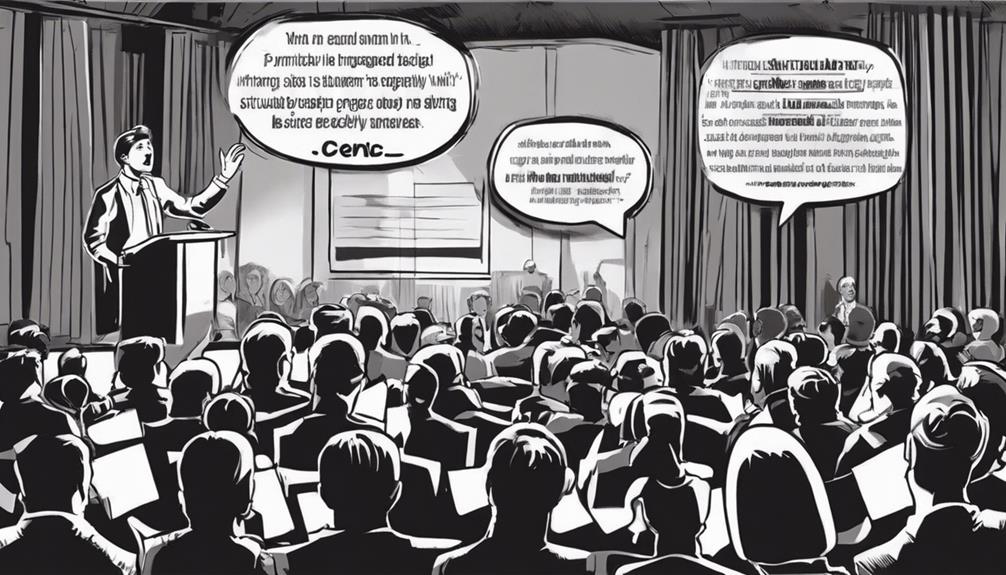
To excel in public speaking, mastering the structure of your speech is paramount for engaging and effectively conveying your message to the audience.
Begin with a compelling opening to grab attention, followed by a clear introduction of the main points. Organize these points logically, supporting them with relevant examples or stories. Guarantee a smooth shift between sections to maintain coherence.
End with a strong conclusion that reinforces your key message and leaves a lasting impact. Practice your speech multiple times to familiarize yourself with the content, tone, pace, and body language.
Embrace non-verbal communication through eye contact, confident posture, and effective gestures. Utilize visual aids sparingly to enhance, not overpower, your message.
Overcoming Stage Fright

Conquering stage fright is an essential aspect of delivering a successful public speech, requiring mastery of self-confidence and effective coping strategies. When facing stage fright, deep breathing exercises and visualization techniques can help calm nerves. It is important to focus on the message, engage the audience, and start with a strong opening. Enhancing presence through confident body language, eye contact, gestures, and voice modulation can also alleviate anxiety. Avoiding fidgeting, speaking clearly, varying pitch, and controlling the pace of speech are key strategies to overcome stage fright. Here is a table summarizing key points:
| Stage Fright Coping Strategies | Examples | Effectiveness |
|---|---|---|
| Deep breathing exercises | Diaphragmatic breathing | Calms nerves |
| Visualization techniques | Imagining a successful speech | Boosts confidence |
| Focus on the message | Engage with the audience | Reduces anxiety |
| Confident body language | Maintaining good posture | Enhances presence |
| Voice modulation | Varying pitch and pace | Controls nervousness |
Handling Q&A Sessions

When moving from delivering a speech to interacting with the audience in a Q&A session, it is important to maintain composure and actively listen to questions being posed.
During Q&A sessions, follow these key strategies:
- Listen Carefully: Pay close attention to each question to provide relevant responses.
- Remain Calm: Stay composed and confident, even if faced with challenging or unexpected queries.
- Engage with Gratitude: Thank the audience for their questions and show appreciation for their participation.
Visual Aids and Message Reinforcement

Utilizing visually appealing aids is pivotal in reinforcing the message delivered during a public speech. Visual aids, such as slides, props, or multimedia presentations, serve to enhance audience understanding and retention of key points.
When incorporating visual elements, it is essential to keep them simple, clear, and complementary to the spoken content. Overloading the audience with visuals can distract from the message, so it's essential to strike a balance that guarantees a memorable speech delivery.
Effective non-verbal cues, gestures, and body language can further reinforce the intended message, creating a cohesive and impactful presentation. Establishing a strong presence on stage through confident posture, eye contact, and appropriate hand movements enhances the overall delivery of the speech.
Frequently Asked Questions
How Can I Effectively Engage a Diverse Audience?
To effectively engage a diverse audience, tailor your content to resonate with their backgrounds and interests. Utilize engaging storytelling, interactive elements, and inclusive language. Encourage participation, listen actively, and adjust your delivery to guarantee everyone feels acknowledged and valued.
What Are Some Strategies to Handle Technical Difficulties During a Presentation?
In the field of public speaking, handling technical glitches demands a calm demeanor, quick thinking, and preparedness. Confirm backup plans for equipment failures, practice with the technology, and maintain composure to troubleshoot effectively.
How Do I Maintain Audience Interest Throughout a Longer Speech?
To maintain audience interest throughout a longer speech, engage them with compelling stories, interactive elements, and relevant examples. Vary your tone, pace, and delivery to keep them attentive. Use visuals sparingly to supplement key points and enhance message retention.
What Are Some Tips for Incorporating Humor Into a Serious Speech?
Incorporate humor strategically by using relevant anecdotes, witty remarks, or light-hearted observations to break tension, engage the audience, and make complex topics more digestible. Balance humor with professionalism to maintain credibility and impact.
How Can I Address Audience Skepticism or Resistance During a Presentation?
To address audience skepticism or resistance during a presentation, employ strategic storytelling, provide credible evidence, acknowledge opposing viewpoints respectfully, and engage in active listening. Build trust by establishing common ground and demonstrating empathy towards differing perspectives for a more receptive audience.
Conclusion
To sum up, mastering the art of public speaking requires careful preparation, confident delivery, and effective message reinforcement. By honing speech structure, overcoming stage fright, and utilizing visual aids strategically, individuals can unlock their full potential as speakers.
Embracing these practices will not only enhance communication skills but also leave a lasting impact on the audience. With dedication and practice, anyone can become a compelling and confident public speaker.
Parenting Tips
Youth Drive Eco-Friendly Revolution Against Plastics
Unleash the power of youth in the fight against plastic pollution by discovering their innovative eco-friendly initiatives and impactful contributions.
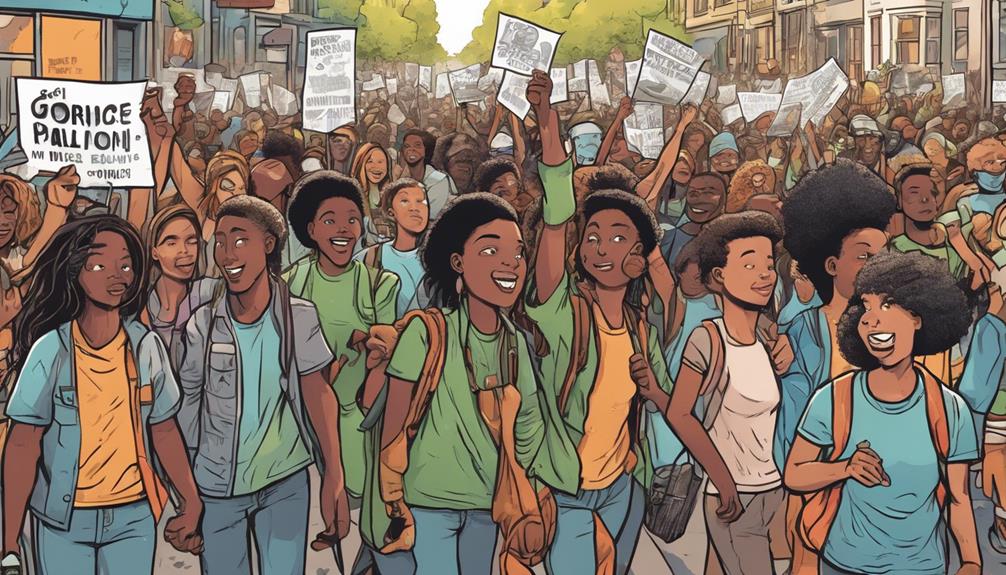
The youth are at the forefront of combating single-use plastics, advocating for sustainable alternatives to tackle the pressing issue of plastic pollution. With 14 million tons of plastic entering the oceans annually, urgent action is essential. Despite challenges like lack of awareness and cheap plastic production, promoting eco-friendly practices, such as using reusable items, and supporting local businesses with green initiatives can make a significant impact. Engaging students in environmental efforts not only instills responsibility but also empowers them to lead the eco-friendly revolution. By educating and involving the younger generation, a cleaner and healthier environment can be achieved.
Key Takeaways
- Educate students on plastic alternatives and eco-friendly practices.
- Empower students to advocate for policy changes promoting sustainable initiatives.
- Encourage students to lead by example in reducing plastic consumption.
- Implement green practices within educational settings to inspire eco-friendly habits.
- Foster a sense of responsibility in students to drive the eco-friendly revolution against plastics.
Impact of Single-Use Plastics
Annually, a staggering 14 million tons of plastic find their way into Earth's oceans, highlighting the detrimental impact of single-use plastics on the environment.
Despite campaigns like Keep Britain Tidy, the persistence of single-use plastics poses a significant threat to marine ecosystems. Organizations are actively working towards replacing these plastics with sustainable alternatives to mitigate the environmental damage caused.
The youth, in particular, are affected by the toxic repercussions of plastic pollution. As plastic waste continues to accumulate in oceans, urgent action is required to address this global issue.
It is essential to raise awareness about the consequences of single-use plastics and promote eco-friendly practices to combat this growing environmental challenge.
Challenges in Reducing Plastic Waste

Despite efforts to raise awareness and promote eco-friendly practices, reducing plastic waste globally presents numerous challenges that hinder progress towards a sustainable future. One major challenge is the lack of awareness on plastic waste and its environmental impact.
Disparity in reducing single-use plastics globally also poses a significant obstacle. The cheap production of plastics makes it challenging to phase them out in favor of more sustainable options.
Additionally, the need for widespread eco-friendly practices is essential but often not implemented on a large scale. Education on the effects of pollution caused by plastics is lacking, further complicating efforts to reduce plastic waste effectively. These challenges highlight the complex nature of addressing plastic waste on a global scale.
Promoting Sustainable Practices

One significant approach to addressing the challenges in reducing plastic waste is by promoting sustainable practices that prioritize eco-friendly alternatives and responsible waste management.
By advocating for the use of eco-friendly alternatives to single-use plastics, such as reusable bags and water bottles, individuals can greatly reduce their plastic consumption.
Supporting local businesses that implement eco-friendly initiatives and encouraging schools to adopt sustainable practices are also effective ways to promote a more environmentally conscious lifestyle.
Additionally, promoting important waste management, such as proper recycling and disposal of plastics, plays a vital role in minimizing the environmental impact of plastic waste.
Engaging Students in Environmental Initiatives
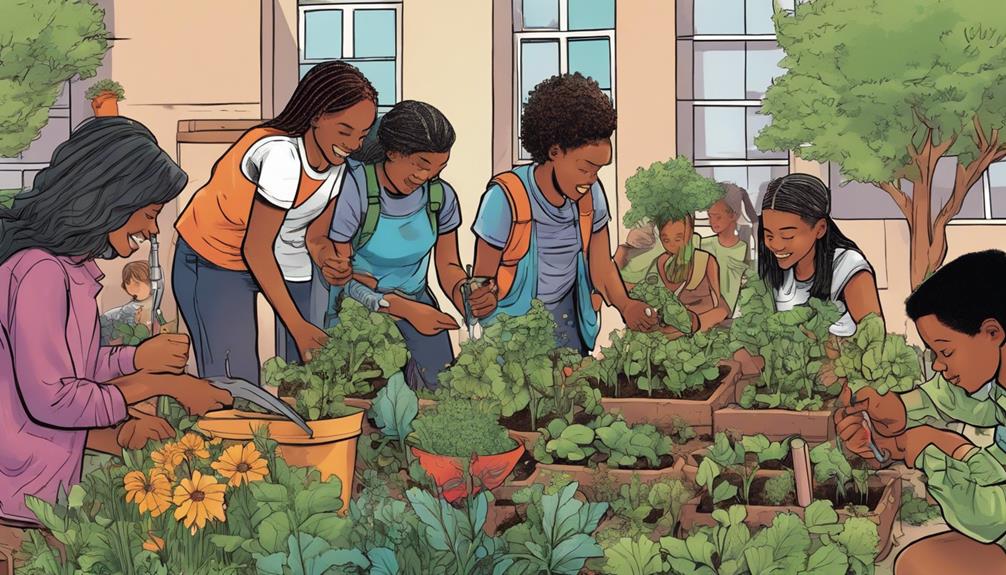
Involving students in environmental initiatives is crucial for cultivating a culture of sustainability and fostering a sense of responsibility towards the environment.
By educating students on plastic alternatives and empowering them to demand eco-friendly products, schools can play a significant role in shaping future environmental leaders.
Implementing green practices within educational settings, such as reducing printing waste and promoting sustainable alternatives, helps students understand the importance of environmental conservation.
Through these initiatives, students can learn the value of responsible waste management and contribute to minimizing their ecological footprint.
Leading Eco-Friendly Revolution
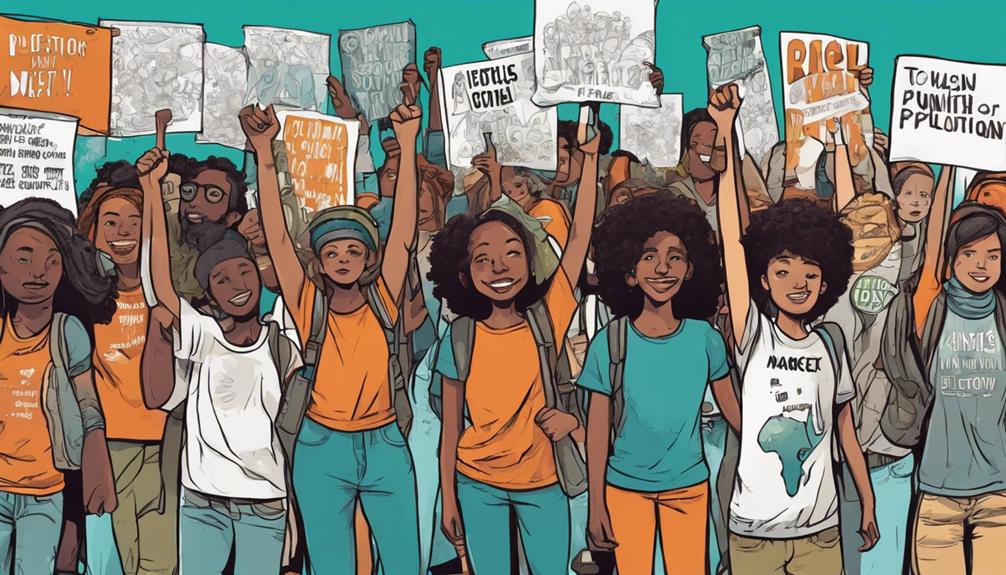
Educating and empowering students on eco-friendly practices is fundamental in leading the eco-friendly revolution towards sustainable living. By instilling a sense of responsibility and understanding the impact of their actions, students can become catalysts for change. Here is a table showcasing key strategies to lead the eco-friendly revolution:
| Strategies | Description |
|---|---|
| Implement Green Practices | Schools can adopt sustainable practices like recycling programs and reducing plastic waste. |
| Advocate for Policy Changes | Students can push for policy changes at school and community levels to promote eco-friendly practices. |
| Lead by Example | Embracing sustainable practices, using reusable items, and volunteering to make a positive impact. |
| Educate and Empower | Educating peers, sharing facts, and demanding eco-friendly products to create a culture of environmental responsibility. |
Frequently Asked Questions
How Can Youth Effectively Influence Companies to Prioritize Recyclability?
Youth can effectively influence companies to prioritize recyclability by engaging in advocacy efforts, leveraging social media platforms to raise awareness, collaborating with environmental organizations, and participating in sustainable initiatives to showcase the demand for eco-friendly practices.
What Innovative Ways Can Schools Implement to Reduce Printing Waste?
To reduce printing waste, schools can implement digital platforms for assignments, utilize double-sided printing, encourage electronic submissions, promote paperless communication, establish printing quotas for students, and educate on eco-friendly practices. These innovative methods foster sustainability and cost-efficiency.
Are There Specific Strategies to Empower Students to Demand Eco-Friendly Products?
To empower students to demand eco-friendly products, schools can educate on sustainable options, encourage activism for environmentally responsible choices, collaborate with local businesses promoting green initiatives, and integrate eco-friendly practices into the curriculum.
How Can Local Businesses Be Supported in Implementing Eco-Friendly Initiatives?
Local businesses can be supported in implementing eco-friendly initiatives by providing financial incentives, offering training on sustainable practices, connecting them with eco-conscious suppliers, and promoting their efforts through community partnerships. Collaboration is key for lasting impact.
What Are the Key Steps to Fostering a Culture of Environmental Responsibility in Schools?
Fostering a culture of environmental responsibility in schools involves educating students on eco-friendly practices, empowering them to demand sustainable solutions, implementing green initiatives, reducing waste, and advocating for policy changes at school and community levels.
Conclusion
To sum up, crucially, the youth-led eco-friendly revolution against plastics showcases the power of collective action in combating environmental threats. By promoting sustainable practices, engaging students in initiatives, and leading the charge for change, these young activists are driving a dynamic shift towards a cleaner, greener future.
Their dedication and determination to tackle the challenges posed by plastic waste serve as a shining example of environmental stewardship and responsibility. Let us all join in this essential mission to protect our planet for generations to come.
Parenting Tips
Unleashing Potential: Bruce Lee's Inspirational Lessons
Discover the transformative power of Bruce Lee's teachings and unlock your potential through philosophy, physical training, and strategic thinking.

Bruce Lee’s life lessons push for growth through **philosophy**, exercise, and smart thinking. Conquering challenges, using strengths in conflicts, and building a good work ethic by training the whole body are key. Staying calm and thinking strategically matter. There are efforts to keep his legacy alive with historic spots and filming sites. You can join in through online groups and social media. As a long-time teacher, the author shares cool ideas on growing personally and learning. Check out related info and chat with others for even more knowledge. **Bruce Lee’s lessons inspire.**
Key Takeaways
- Philosophy of hard work and continuous improvement for personal growth.
- Leveraging strength for conflict resolution and strategic responses.
- Training every part of the body for a strong work ethic.
- Preserving Bruce Lee's legacy through historic locations and landmarks.
- Engage with online community for educational insights and inspiration.
Influence on Personal Growth
Bruce Lee's philosophy of physical training and hard work propelled me to conquer personal challenges and embrace a mindset of continuous improvement. His belief in leveraging the enemy's strength to handle conflicts calmly resonated deeply within me.
The emphasis he placed on training every part of the body inspired a strong work ethic that I aim to embody daily. One of the key takeaways from Lee was the ability to remain composed in the face of provocation and respond strategically.
Witnessing how he lived out his teachings emphasized the importance of leading by example, a principle I now hold close to my heart. Bruce Lee's influence continues to shape my approach to personal growth and self-improvement.
Legacy Preservation Efforts

Efforts are underway to secure and preserve historic locations in Pak Chong related to Bruce Lee's legacy. The Big Boss house, an important filming spot, has remained largely unchanged since 1971.
Plans for the refurbishment of Wat Siri Samphan, the temple at the filming site, are in progress. Collaborative initiatives are working diligently to maintain iconic structures for future generations to appreciate.
These preservation endeavors aim to honor Bruce Lee's profound impact on martial arts and cinema. By safeguarding these filming sites and historical landmarks, the legacy of Bruce Lee can be protected and celebrated for years to come.
The commitment to preserving these significant locations showcases the enduring influence and importance of Bruce Lee's contributions to the world of entertainment and martial arts.
Community Engagement Opportunities

Engage with a network of like-minded individuals passionate about preserving historical landmarks by joining the Richard Rogers online community for daily updates on educational content.
Stay connected by following on Twitter and liking the Facebook page.
Engage with like-minded individuals interested in education and Bruce Lee's legacy.
Connect with a network of individuals passionate about preserving historical landmarks.
Opportunities to contribute to initiatives preserving Bruce Lee's impact are available.
Author Background and Expertise

My background includes being a high school science and mathematics teacher with a BSc (Hons) in Molecular Biology from Bangor University. I also hold a PGCE in Secondary Science Education and a Certificate in Mathematics.
Additionally, I'm an award-winning author of 'The Quick Guide to Classroom Management' and have experience in blogging on topics related to education, science, and mathematics teaching. With a strong foundation in both scientific knowledge and pedagogical skills, I aim to provide valuable insights and educational content to readers.
My expertise lies in creating engaging and informative material that resonates with individuals interested in personal growth, education, and the legacy of inspirational figures like Bruce Lee.
Related Content and Interaction

Exploring various articles by Richard James Rogers provides valuable insights on education, personal growth, and the legacy of inspirational figures like Bruce Lee. When investigating related content and interaction, readers can expect the following:
- Read more articles by Richard James Rogers covering education and personal growth topics.
- Gain deeper insights into Bruce Lee, Pak Chong, and 'The Big Boss' movie.
Engage with the author through comments, shares, and likes on blog posts.
- Stay updated on new publications and educational resources.
These interactive opportunities allow readers to explore further into the teachings of Bruce Lee and the impact he's had on personal growth and education.
Frequently Asked Questions
How Can I Incorporate Bruce Lee's Teachings Into My Daily Life?
I incorporate Bruce Lee's teachings into my daily life by applying his philosophy of hard work and using challenges as opportunities for growth. I remain calm, focus on training every aspect, and lead by example.
What Other Historic Landmarks Related to Bruce Lee Are Being Preserved?
Other historic landmarks related to Bruce Lee being preserved include the Big Boss house and Wat Siri Samphan in Pak Chong. Collaborative efforts are underway to maintain these iconic structures and secure his legacy for future generations.
What Types of Educational Content Can I Expect in the Online Community?
In the online community, expect a diverse range of educational content covering topics like personal growth, Bruce Lee's philosophy, historical preservation efforts, and community engagement opportunities. Stay informed, inspired, and connected with like-minded individuals.
Can Richard James Rogers Provide Personalized Teaching Advice?
Yes, I can provide personalized teaching advice. Drawing from my experience as a high school science and mathematics teacher, I offer tailored guidance to support educators in enhancing their classroom management and instructional strategies.
Are There Opportunities for Readers to Contribute Their Own Stories or Insights?
Yes, there are opportunities for readers to contribute their own stories or insights. I encourage sharing personal experiences and insights to foster a collaborative learning environment and enrich our community with diverse perspectives.
Conclusion
To sum up, Bruce Lee's timeless teachings on unlocking potential serve as a beacon of inspiration for individuals seeking personal growth and empowerment.
As the legendary martial artist once said, 'Be like water.' This adage encapsulates the essence of adaptability and resilience, urging us to flow and evolve with life's challenges.
Through embracing Bruce Lee's philosophy, we can tap into our inner strength, overcome obstacles, and aim for greatness in all aspects of life.
-

 Parenting Styles1 week ago
Parenting Styles1 week agoWorst Parenting Style: Impact on Child Development
-

 Parenting Styles1 week ago
Parenting Styles1 week ago2023 Indiana Parenting Time Guidelines Update
-

 Vetted7 days ago
Vetted7 days ago15 Best Books on Step Parenting Every Blended Family Needs to Read
-

 Parenting Tips6 days ago
Parenting Tips6 days agoUnequal Responsibilities: When One Parent Does All the Parenting
-

 Parenting Tips1 week ago
Parenting Tips1 week agoFostering Love: How Much Do You Get Paid for Foster Parenting?
-

 Vetted6 days ago
Vetted6 days ago15 Best Parenting Books of All Time Every Parent Should Read
-

 Vetted19 hours ago
Vetted19 hours ago15 Best Co-Parenting Books Every Parent Should Read for Successful Co-Parenting
-

 Vetted6 days ago
Vetted6 days ago15 Best Books for Gentle Parenting Every Parent Should Read


















